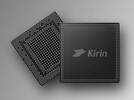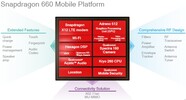HiSilicon Kirin 710 vs Qualcomm Snapdragon 660
HiSilicon Kirin 710
► remove from comparison
The HiSilicon Kirin 710 is a ARM-based mid-range Octa-Core-SoC for Android based smartphones and tablets. It was announced mid 2018 and contains 8 processor cores (4x Cortex-A73 at up to 2.2 GHz, 4x Cortex-A53 at up to 1.7 GHz, BigLITTLE), an ARM Mali G51 MP4, a dual-channel LPDDR4 memory controller and a LTE radio (600 Mbps down, 150 Mbps up). Therefore, the CPU part is similar to the Kirin 960 and 970 (both higher clocked), but the graphics card is a lot slower.
The Kirin 710 is manufactured at TSMC in 12 nm (compared to the 16nm Kirin 960 and 10nm Kirin 970).
The HiSilicon Kirin 710F is the same chip with a different package (FCCSP - Flip Chip Chip Scale Package) and offers the same specifications (see e.g. our review of the Huawei P Smart Z).
Qualcomm Snapdragon 660
► remove from comparison
The Qualcomm Snapdragon 660 (SD660) is a fast mid-range ARM-based SoC largely found on Android tablets and smartphones. Announced in mid 2017, the SD660 is the successor to the Snapdragon 625. It features 8 Kryo 260 cores (custom design, 64-Bit capable) that are divided in two clusters. A fast cluster of four cores with up to 2.2 GHz and a power saving efficiency cluster with up to 1.8 GHz. Both clusters can also used together.
In addition to the 8 CPU cores, the SoC integrates a mid range Adreno 512 GPU with a LPDDR4 memory controller (dual-channel 1866 MHz) and supports Wi-Fi (802.11ac + MIMO, max. 867 Mbps), Bluetooth 5, and LTE (X12 LTE modem with up to 600 Mbps download and 150 Mbps upload).
Performance
In Benchmarks of the Oppo R11, the CPU part of the Snapdragon SD660 performs between former high end Socs like the Snapdragon 821 in the Pixel XL and the Snapdragon 835. The graphics performance is however much lower, as the Adreno 512 is only a slight upgrade of the older Adreno 510 (due to the higher clock speed).
CPU
The Snapdragon 660 is based on a similar concept as ARM's big.LITTLE, which combines a low power CPU cluster (2x Kyro clocked at up to 1.8 GHz) and a performance CPU cluster (2x Kyro clocked at up to 2.2 GHz). The clock speed of each cluster can be individually adjusted (but not per core) and the lowest clock speed is 310 MHz (unverified).
Power Consumption
Thanks to the new 14 nm process, the energy efficiency has been improved noticeably compared to its 20 nm predecessors.
| Model | HiSilicon Kirin 710 | Qualcomm Snapdragon 660 | ||||||||||||||||||||
| Codename | Cortex-A73/-A53 | Kryo 260 | ||||||||||||||||||||
| Clock | 2200 MHz | 2200 MHz | ||||||||||||||||||||
| Cores / Threads | 8 / 8 | 8 / 8 | ||||||||||||||||||||
| Transistors | 5500 Million | |||||||||||||||||||||
| Technology | 12 nm | 14 nm | ||||||||||||||||||||
| Features | ARM Mali-G51 MP4 GPU, 4x Cortex-A73 (2.2 GHz) + 4x Cortex-A53 (1.7 GHz, big.LITTLE), LTE Cat-12 600 Mbps Downlink, Cat-13 150 Mbps Uplink, Bluetooth 4.2, WiFi a/b/g/n 2.4 GHz, AGPS, Glonass, Baidou | Adreno 512 GPU, X12 LTE Modem, Hexagon 680 DSP, Specra ISP | ||||||||||||||||||||
| iGPU | ARM Mali-G51 MP4 | Qualcomm Adreno 512 ( - 850 MHz) | ||||||||||||||||||||
| Architecture | ARM | ARM | ||||||||||||||||||||
| Announced | ||||||||||||||||||||||
| Series | Qualcomm Snapdragon | |||||||||||||||||||||
| Series: Snapdragon Kryo 260 |
| |||||||||||||||||||||
| Manufacturer | www.qualcomm.com |
Benchmarks
Average Benchmarks HiSilicon Kirin 710 → 100% n=35
Average Benchmarks Qualcomm Snapdragon 660 → 96% n=35
* Smaller numbers mean a higher performance
1 This benchmark is not used for the average calculation













